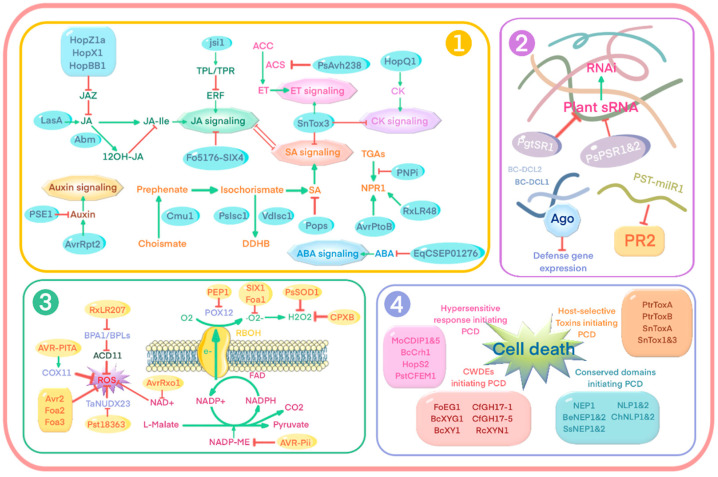Figure 5.
Effectors manipulate downstream immune responses in host plants. Effectors mainly manipulate plant downstream immune responses by interfering with plant hormone transduction, disrupting plant RNA silencing, regulating ROS generation, and manipulating plant cell death. The effector chorismate mutase Cmu1 of Ustilago maydis, the oomycete pathogen Phytophthora sojae and the fungus Verticillium dahliae effectors PsIsc1 and VdIsc1, POPs in Ralstonia solanecearum, P. striiformis f.sp. effector PNPi, P. syringae effector AvrPtoB, HopZ1a, HopBB1, HopX1, HopAF1, AvrRpt2, HopQ1, Phytophthora capsicum effector RxLR48, F. oxysporum Fo5176-SIX4, rice blast effector ABM, LASA of L. medterranea, Phytophthora sojae RxLR effector PsAvh238, Phytophthora effector PSE1 and EqCSEP01276 of Erysiphe quercicola SnTox3, interfere with the transduction of different hormone signals in plants. The wheat stem rust Puccinia graminis f. sp. tritici effector protein PgtSR1, PsPSR1 and PsPSR2 in Phytophthora sojae, Botrytis cinerea BC-DCL1 and BC-DCL2 and PST-milR1 are gene silencing mechanisms. The maize smut effector PEP1, the biotrophic pathogen Puccinia striiformis PsSOD1 and avirulent proteins AVR-PII, AVR-PITA in M. oryzae, inhibit ROS accumulation. The M. oryzae effector enhances COX activity by interacting with mitochondrial OsCOX11; OsCOX11 is a key regulator of mitochondrial ROS metabolism in rice. RxLR207 in Phytophthora capsici can promote the degradation of BPA1, BPL1, BPL2, and BPL4, and destabilize ACD11 in a 26S proteasome-dependent manner to promote ROS accumulation and PCD activation. F. oxysporum apoplasts (SIX1 and Foa1) and cytoplasmic effectors (Avr2, Foa2 and Foa3) promote host colonization by inhibiting flg22-induced or chitin-induced ROS. There are four main types of effectors that cause cell death, namely effectors that trigger HR responses, host-selective toxins, cell wall-degrading enzyme effectors, and effectors with conserved necrosis-inducing domains.

